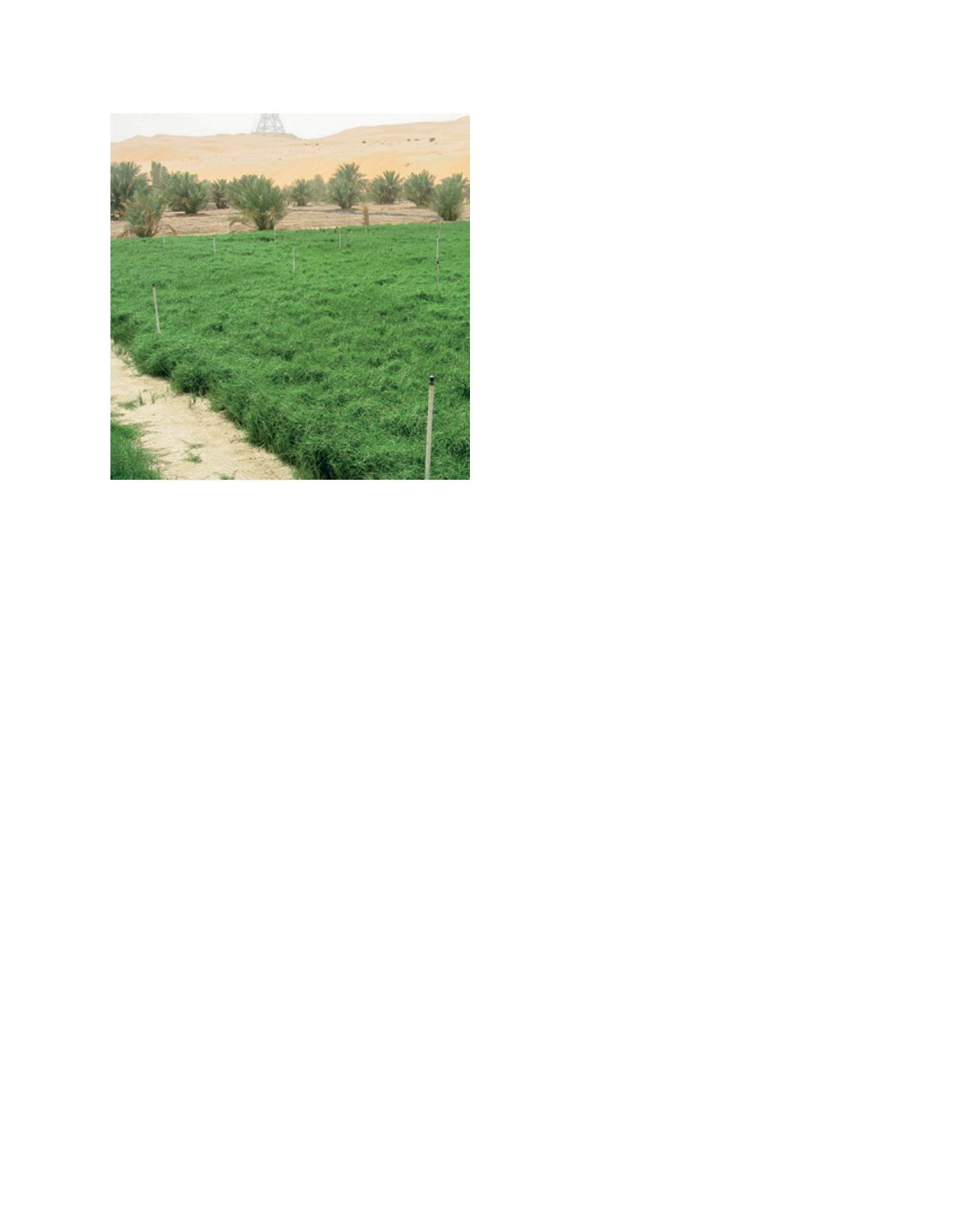

[
] 148
(
Portulaca oleracea
), jute mallow (
Corchorus olitorius
), rocket
(
Eruca sativa
and
Diplotaxis tenuifolia
), safflower (
Carthamus
tinctorius
) and wild drumstick tree (
Moringa peregrina
) have
considerable value in terms of their tolerance to salinity and
harsh climatic conditions. Many such species have the potential
for more widespread use and their promotion could contrib-
ute to food security, agricultural diversification and income
generation, particularly in areas where cultivation of major
crops is constrained or economically unviable. Similarly, salt-
and drought-tolerant non-native species such as leaf mustard
(
Brassica juncea
), quinoa (
Chenopodium quinoa
), salicornia
(
Salicornia bigelovii
), guar (
Cyamposis tetragonoloba
) and
amaranth (
Amaranthus cruentus
) which showed good adapta-
tion in field trials under harsh conditions in the UAE, are likely
to be of value in providing cost-effective and long-term solu-
tions to problems of water shortage and increasing salinity of
soil and water resources in the region. Besides their tolerance to
abiotic stresses, all these species are nutritionally rich and can
thus play a crucial role in combating vitamin and micronutrient
deficiencies frequently experienced by inhabitants of marginal
environments. Research to improve the productivity and value
of these crops, and to encourage them to be more widely
cultivated, would contribute to food, income and nutritional
security for smallholder farmers in marginal environments.
Medicinal crop production systems
In combating desertification, integration of biodiversity conser-
vation into economic development — accomplished through
sustainable production and commercialization of natural prod-
ucts derived from native plants — is beginning to emerge as a
major strategy in several countries. Deserts harbour a variety
of flora adapted to the dry conditions and surviving for several
years without water. The medicinal value of these plants is well
known, for example, nearly 20 per cent of the 750 native plant
species documented in the UAE are known to have medicinal
properties. Two good example are
Aloe vera
(sabar), a shrubby
xerophytic, succulent plant used for centuries for its health,
beauty, medicinal and skincare properties, and
Cynomorium
coccineum
(tarthuth) a parasitic plant considered as a ‘treasure
of drugs’ because of its numerous traditional therapeutic uses
in treating colic and stomach ulcers, piles, nosebleeds, dysfunc-
tional uterine bleeding and as a contraceptive. Most medicinal
plants are still being collected from the wild population and
many are being seriously threatened by overgrazing and habitat
degradation. According to the UAE Red Data plant list, of the 132
species of medicinal plants, six species fell under the threatened
category. Thus, it is important to integrate commercial exploita-
tion with action plans for sustainable conservation and use.
Seawater and brine-based systems
To provide additional income and reduce the poverty cycle,
improving water supply for human consumption and irrigation
purposes requires the desalination of groundwater. Approximately
15 per cent of farmers in the Arabian Peninsula have installed
small-scale reverse osmosis (RO) plants to desalinate the ground-
water for field crop irrigation. These RO plants produce highly
concentrated brine which can be used as a resource under best
management practices. A project to showcase the potential of a
farming system using seawater-level brine was developed in the
UAE. The desalinated water is used to irrigate a large variety
of high-value vegetable crops (such as asparagus, eggplant and
radish). The produced brine is used for aquaculture, followed by
irrigation of salt-tolerant forages and halophytic plants. The mari-
culture system contains fish, sedimentation and seaweed tanks.
Two fish species (sobaity seabream and tilapia) showed adapt-
ability to the fish tank conditions in the Emirati climate. One of
the halophytic species irrigated with brine is
Salicornia bigelovii
,
a multipurpose species that can be used as a vegetable, biofuel
or fodder. Previous research found that cultivating the proper
salicornia varieties, combined with suitable agronomic practices,
could be economically viable and successful in marginal land.
Production systems based on treated wastewater
Arab countries are expected to face severe water scarcity as early
as 2015, when the annual per capita water share in the region
will fall to less than 500 m
3
. Give that agriculture uses 70-80
per cent of all water, the reuse of reclaimed (treated) wastewa-
ter for irrigation could contribute considerably to the reduction
of water scarcity for domestic use. In many countries of the
Arabian Peninsula, due to the problem of social acceptance and
the perception of health risks, municipal wastewater, even after
tertiary-level treatment, is not used for growing food and feed
crops. In the UAE, of the 600 MCM of tertiary-treated wastewa-
ter produced per year, 58 per cent (352 MCM) is used mainly
for landscaping and the rest is discharged into the sea. In fact,
reclaimed wastewater can be a valuable resource to grow bioen-
ergy crops for the specific purpose of producing liquid fuels, with
considerable economic and environmental benefits, when social
barriers prevent its use for growing edible crops. If bioenergy
crops can be cultivated on a commercial scale, they can reduce
pressure on fossil fuels while simultaneously improving environ-
mental quality and reducing desertification/soil erosion which is
also a matter of serious concern in the region.
Salt-tolerant and drought-tolerant plants allow the use of marginal water
resources to increase plant production and reduce overgrazing
Image: ICBA
L
iving
L
and
















